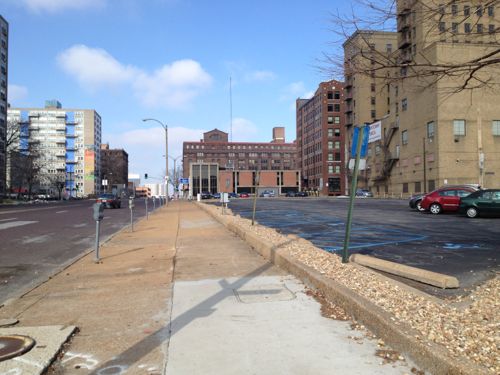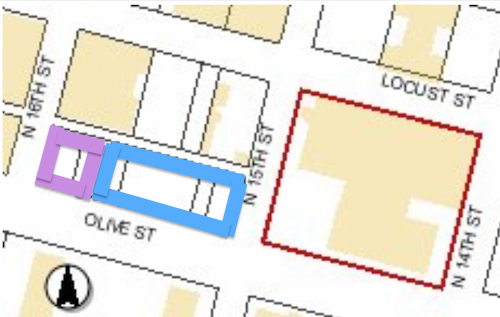Potential Development Sites Along Proposed Streetcar Line, Part 1: Olive 15th-16th
The proposed streetcar from St. Louis’ central business district (CBD) to the Central West End (CWE) along Olive/Lindell is moving forward. Regular readers know I’m a streetcar advocate because of how it can increase development activity in a way no bus route ever can. I thought I’d take a close look at potential sites along the proposed route, starting with the area nearest my loft.
The block on the north side of Olive between 15th and 16th is nothing but two surface parking lots.

The larger lot with entrance on 15th serves the building the occupies the block to the east. This building contains the administrative offices for the St. Louis Public Library and the Confluence High School. That building contains parking underneath as well as some surface parking within that block. The library owns the building and this surface parking lot.
The surface lot, shown above, doesn’t get much use. Once the streetcar line starts running there won’t be as much need for automobile parking, hopefully the library can sell the large surface overflow parking lot to a developer for new construction. This is currently subdivided into 4 parcels with addresses 1501 Olive, 1507 Olive, 1509-1529 Olive, and 1527 Olive with a total area of 26,964sf or 0.62 acres. See map.
The west end of the block is a smaller privately-owned public surface parking lot, legally divided into two parcels with addresses 1531-1533 Olive and 1535-1537 Olive. The total area of these two parcels is 11,676sf or 0.27 acres. Combine all six parcels owned by two entities and you have 38,640sf or 0.89 acres.

The only structures on this city block are The Campbell House Museum and the 10-story YMCA. The 100 upper floor apartments have been vacant for at least 5 years now, hopefully a streetcar line will get someone interested in taking on the project. Other buildings in the area range from 1-10 floors, but most are greater than 5.
A stop is highly unlikely at 15th because the streetcar line will have a major connection at 14th, but I’d like another stop at 16th or 17th. Even if the next stop isn’t until 18th or 19th I can see this block filled in with apartments and/or condos along with new ground-floor restaurant/retail space.
— Steve Patterson
I consider your projections about usage to be optimistic and perhaps naive, but I hope I’m wrong. And any effort to eliminate parking in the route areas needs to be carefully reconsidered until/unless the project proves itself worthy. I personally feel the streetcar plan along Olive will become a failed attempt to encourage the use of public transportation and that locals will consider riding it once or twice as a novelty, or perhaps as a venue to take out-of-town guests to, provided the presence of local thugs doesn’t discourage law-abiding motorists from doing more than driving by the streetcar and curiously looking at it . But only a handful of locals will consider using it long-term or even daily.
If surface parking lots are retained rather than developed densely then the streetcar will most certainly fail. If new housing options are offered along the line they will be occupied quickly.
You are right Steve! No more surface parking lots. NO MORE. All parking goes underground. Forget parking for now anyway. You have to have building first to park anywhere! Do like the Europeans do, and you shall see the change. St. Louis start being a European city.
Local thugs? Really? On what planet do you live? This statement does not reflect reality. At least the reality of the City of St. Louis I live in.
Insofar as “local thugs” are a consideration, surface parking lots have proven to be prime venues for crime of all kinds. The relative isolation of the surface parking lot lends it to car cloutings, break ins, jackings, and all kind of assaults. If one is a criminal, what better place to scope out prime pigeons than a big-ass surface parking lot when nearby bars close? There go two women with purses, walking toward a nice shiny car, absorbed in conversation, relaxed after a bunch of Sea Breezes. They’re a prime roust for any “local thug”, served up under the bright light of a conveniently located surface lot.
Years ago on S. Grand, we were told that more parking, i.e., surface parking lots, was needed in order for “people to feel safe in the district.” As surface parking availability increased, so did anecdotes of broken car windows, purse snatchings, and worse. It’s a classic example of something “biting back”, that is, something intended to provide greater safety but inadvertently creating an expanded venue for diminished safety.
Crowds of people provide safety and the image of safety. People walking up and down, night and day. You can walk on any street in Manhattan at any hour of the day or night and feel safe, mostly because the streets are full of people doing the same thing. True, some may be obnoxious drunks or creeps, but the sheer numbers negate that impact. In any case, I feel much safer on a crowded bus anywhere than in a vast parking lot or parking garage anytime.
So, is the street car line really not going to go down Washington Ave?
No, and it shouldn’t. Washington Ave is already developed. Based on the current planningm east of 14th the streetcar would be eastbound on Olive and westbound on Locust.
I disagree. I’m reading Jeff Speck’s book “Walkable City” right now and his take (which I am inclined to agree with) is that street cars work best as “pedestrian accelerators” and should be place on the streets in neighborhoods where there are already the most pedestrians and should be used to expand the area of the street that is walkable/vibrant. He also shows examples of attempts by cities to stimulate development by placing street cars on streets on streets without much pedestrian activity haven’t been as successful.
The street car installation that’s going in on Delmar Blvd is the ideal type according to Spec. The street already has many pedestrians and hopes to expand the walkable/vibrant part of the street further east into the somewhat blighted part.
(See #VI: http://nextcity.org/daily/entry/sidetracks-in-jeff-specks-walkable-city)
Basically what I’m trying to say is that it’s a good idea to run it down other streets downtown to encourage development but it also should go down the most active parts of Wash Ave.
One of the best things of the plan in my opinion is that there will be a taming of the huge overcapacity of Olive west of Tucker. Essentially it will be a greenway with comfortable bike lanes from SLU to downtown. That’s pretty cool and can only happen on Olive.
I agree with his premise but the circumstances must be considered. Washington Ave from Tucker (12th) to !8th was redone a decade ago at considerable cost. This would have to be completely redone again to accommodate a streetcar. Plus Tucker to 14th is designated a festival street area and is often closed for events, like Cinco de Mayo. Locust is one short block to the south, people can walk. By placing the streetcar line a block from the existing activity it’ll help expand what we already have.
That’s just the sunk costs fallacy. Plus, there are ample numbers of empty (or nearly empty) streets to have festivals in in downtown. I suspect the real reason they want the street car run on less busy streets is so that it won’t inconvenience drivers. This is good for drivers but less good for the success of the street car line. Ideally you’d be able to step out of your apartment, a restaurant, bar, coffee shop, store, stadium(?), convention center, hotel and into a street car. Even a one block walk will reduce ridership.
I really do hope the new line spawns development on these underutilized blocks but I suspect that running a street car on an underutilized block will result in an underutilized street car.
I have considered this and have written to Metro many years ago about this! We have a long way to go…..but chicago does not even hardly use cars anymore and I have said that we must give the people something to encourage public transportation….when one thing does not work….can take another….like in San Francisco…rode on one of our old streetcars many years ago. Often wonder why our history is others towns profiting and helping the people be able to get around…when we could be using right here in the Gateway to the West, Saint Louie, Missouri!
I think it really varies even in the metro areas with stronger transit offerings. As a previous townhouse owner in Chicago western suburbs it was very easy for my neighbors to commute downtown on Metra. However, I worked for a company based in Oakbrook and cars are very much healthy way to commute. Yes, there is some neighborhoods within the city but for the most part greater Chicago has been expanding freeways.
The same could be said for my new home in the Bay area. Would love to have my office be in downtown San Fran. BART is five minutes from my house. However, my new job/office is in Marin/North Bay while my wife was able to transfer her job to the East Bay (She used to work downtown St. Louis at One ATT Center). Once again, cars are very much a big part of the Bay area’s commute and the only realistic timely way I can get back/forth to work. Otherwise, my family would never see me and I have no problem taking a car over transit because it means a few hours in the evening with my family instead of spending time taking multiple transfers between different transit agencies even if it is possible with my commute. Also, Don’t forget that Muni is a financial mess and not every city is going to have the tourist traffic to foot $56 a pop for a round trip on a cable car ride to help things work (my family experience when friends from St. Louis were visiting because of a conference in town).
To Steve’s post, I really think St. Louis has to be selective in its Transit choices. To me, this streetcar proposal makes a lot more sense than a new metrolink Westport line. I also think the choice of streets for the most part is good. As Steve noted, Wash Ave is literally only a block away of the proposed route and has been rebuilt nor does it have the street width to really give you functioning as good of a transit system as desired. Having a streetcar backed up in traffic on Wash Ave is going to do as just as much or more harm to ridership when people see walkers go past them. Olive has enough width to separate car traffic and the streetcar.
*
Another way to put it, which gets back to Steve’s post. What transit option gives you the area the best chance to develop dense, walkable neighborhoods where car ownership truly becomes a option instead of a means to maintain employment while also extending a successful redevelopment/growth of existing dense, walkable neighborhood a block away. I think the Olive routing does that. The other key note, this streetcar routing connects a downtown central business district/residential with an arts center/university with the biggest hospital/employer in the region (not to mention a medical school/nursing school/pharmacy school)